Model Farm Technical Evaluation(1)
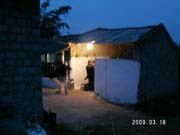 Arriving at the farm in the darkness(MC)
Arriving at the farm in the darkness(MC)
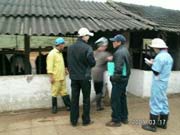 Evaluation team (C/P, LT, expert) (MC)
Evaluation team (C/P, LT, expert) (MC)
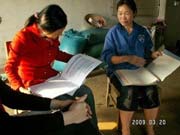 Asking farmer about recording Method and farm management related information (MC)
Asking farmer about recording Method and farm management related information (MC)
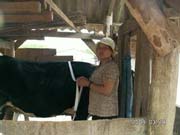 A model farmer estimating body weight Of her heifer by the measure scale Introduced by the Project (MC)
A model farmer estimating body weight Of her heifer by the measure scale Introduced by the Project (MC)
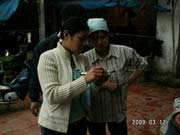 A C/P shows a model farmer howTo read thermometer (VT)
A C/P shows a model farmer howTo read thermometer (VT)
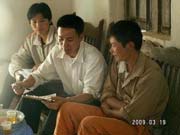 A C/P explains about using CMT tray (MC)
A C/P explains about using CMT tray (MC)
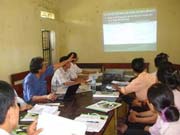 A model farm evaluation meeting held before the 2ndevaluation (VT)
A model farm evaluation meeting held before the 2ndevaluation (VT)
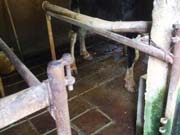 Improved floor conditions at Mr.Phong farm (VT)
Improved floor conditions at Mr.Phong farm (VT)
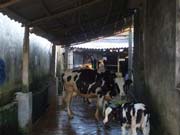 New roof built At Mr.Hafarm (VT)
New roof built At Mr.Hafarm (VT)
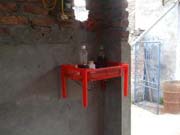 An improved conditions for the place of keeping Drugs and sanitary stuffs (MrViet, VT)
An improved conditions for the place of keeping Drugs and sanitary stuffs (MrViet, VT)
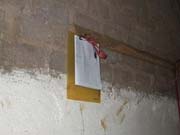 A hanged writing board for immediate recording purpose kept in milking shed at Ms.Lanhfarm, MC
A hanged writing board for immediate recording purpose kept in milking shed at Ms.Lanhfarm, MC
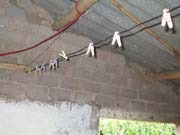 Many cloth hangers signify a better preparation for milking (MC)
Many cloth hangers signify a better preparation for milking (MC)
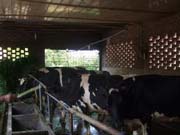 Installed water spray system and added one ceiling layer for improved heat radiation cut into cattle shed at Mr.Sung, VT
Installed water spray system and added one ceiling layer for improved heat radiation cut into cattle shed at Mr.Sung, VT
- Since the beginning of the year 2009, after Model Farm Technical Evaluation activity was approved in the JCC meeting, the Projects has started this activity 2 times in two target areas. The main purpose of this periodical evaluation is to monitor improvement progress of dairy farms in Project’s target areas and timely recommend and provide technical guidance to them.
- As one of Project’s purpose is to improve dairy techniques of at least 20 model farms and others in the North of Vietnam, the Project needed to design a tool to verify this improvement level. To serve this purpose, the Model Farm Technical Evaluation Sheet was created to enable the Project to conduct more objective evaluation.
- Based on analysis and evaluation results gained by the sheet, the Project could draw out some general characteristics of each model farm and the target area, and, at the same time, the Project could provide dairy farmers with comments and recommendations that are expected to serve as useful information for their farm management.
- The 1stevaluation activity was conducted in March 2009. Normally, evaluation team included Project’s experts (MrKoji Shimokawa-long term expert, MrSaito Satoshi-Project’s Chief Advisor), counterparts (2 persons), 1 Local technician. All 10 model farms were visited and evaluated in turns during milking time (1 farm in early morning and 1 farm in late afternoon, so normally, it took about 5 days to complete the evaluation).
- Referring to the evaluation procedure, with the farm observed in early morning, the team arrived at his/her farm around 5 AM, then the team observed farmer’s practices during pre-milking and milking hours. After the farmer finished milking, the team interviewed them for about 30 -60 minutes, in which questions related to recording method, feeds and feeding condition, reproductive conditions, etc.. were made. For evaluation in the afternoon, the team conducted observation and interview in reversed manner. The team arrived at farm around 3.00 PM, and conducted interview with farm owners first, and then proceeded with observation during the milking hour.
- Based on what we asked and observed, we would give marks to each technical aspect which already set in the evaluation sheet. It should be noted that in this 1stevaluation, we not only evaluated but also provided with model farm owners, a full set of recording material (recording book, clip file, notebook, pen, measuring scale), CMT tray (hand-made) and CMT solution for mastitis control program, and a thermometer for checking regularly cattle body’s health condition).
- After each evaluation period, Project’s experts and counterparts made a summary report to send back to the related local authority and each model farm. In addition, the Project also held a meeting with 10 model farms in each target area to have direct talks and get some leanings from the evaluation’ results.
- The 2ndevaluation activity was carried out in July 2009 which was quite similar as the 1stone. One different thing was, in this time, only 8 model farms in each target area were evaluated except for the 2 farms in each area , that are regularly visited and evaluated under Monthly Milk Recording activity (Mr. Bien and Ms. Dang farms in MocChauand Mr. Thanhand Mr. Viet farms in VinhThinh).
- In the 2ndevaluation, the evaluation team saw certain improvements in the model farms’ farm management practice both in VinhThinhand MocChauas shown in the picture:
- (to be continued…)
